出色的社区网站
游戏设计分析 (GAME DESIGN ANALYSIS)
The Last of Us became an instant classic the day it was released, back in 2013. At the sunset of the sixth console generation, it felt like Naughty Dog managed to raise the bar in all critical areas of game development simultaneously. The authentic characters, compelling story-telling, both the technical and artistic excellence: this game nailed everything.
《 Last of Us》于2013年发行之日就立即成为经典之作。在第六代游戏机落日之际,感觉就像Naughty Dog设法在游戏开发的所有关键领域中同时提高了标准。 真实的角色,引人入胜的故事讲述,以及技术和艺术上的卓越表现:这款游戏钉住了一切。
The Last of Us has so many outstanding attributes to mention that relatively few people discuss its game design qualities. That’s a good problem to have if you ask me.
《最后的我们》拥有众多出色的属性,因此很少有人讨论其游戏设计质量。 如果你问我,那是一个好问题。
People tend to overlook it precisely because game designers have put a tremendous amount of effort to blend the mechanics into the flow. The systems subtly convey the intentions, themes, and setting of the experience without ever having to take the spotlight away from the story.
人们往往会忽略它,因为游戏设计师付出了巨大的努力来将机制融合到流程中。 这些系统巧妙地传达了意图,主题和体验背景,而无需将焦点从故事中移开。
Bad design is immediately noticeable. Excellent design is invisible.
错误的设计会立即引起注意。 优秀的设计是看不见的。
I was studying game design when The Last of Us released, and I remember finding the crafting system to be well-conceived at the time. Years later, I had to design a complete crafting system myself; it was the first inspiration that came to my mind. With much more experience, I got a better understanding of why it’s so effective at what it does.
当《我们的最后时刻》发行时,我正在研究游戏设计,我记得当时发现的手工制作系统是精心构思的。 多年后,我不得不自己设计一个完整的制作系统; 这是我想到的第一个灵感。 有了更多的经验,我对为什么它如此有效的原因有了更好的理解。
In this article, I detail each component of the crafting system, explain the intentions behind Naughty Dogs’ creative choices and explain how they smartly solve complex design problems.
在本文中,我详细介绍了制作系统的每个组件,解释了顽皮狗创意选择的意图,并解释了它们如何巧妙地解决复杂的设计问题。

什么是手Craft.io(什么不是) (What crafting is (and what it’s not))
Crafting is one of these catch-all terms in gaming. In The Last of Us, it’s the following 3-steps process:
手工制作是游戏中这些通俗易懂的术语之一。 在《我们的最后时刻》中,该过程分为以下三个步骤:
Collect crafting supplies.
收集手Craft.io品。
Transform them into items in the dedicated Crafting menu.
将它们转换为专用“ 制作”菜单中的项目。
Use the crafted items to overcome gameplay situations.
使用精心制作的物品来克服游戏上的情况。

您如何处理手工系统的设计? (How do you approach the design of a crafting system?)
When I started the design of crafting in Ghost Recon: Breakpoint, I quickly faced a ‘chicken and egg problem’ and realised it’s not the type of system you can figure out independently from its content.
当我开始在《 Ghost Recon:Breakpoint》中进行Craft.io设计时,我很快遇到了“鸡和蛋的问题”,并意识到这不是您可以独立于其内容而解决的系统类型。
You can essentially boil down a crafting system to the following three elements: a series of input elements, a set of outputs and transformation rules from one to the other. And you can’t match just any input with any output: the conversion must be logical and coherent. Whichever comes first shapes how the other needs to be.
基本上,您可以将Craft.io系统简化为以下三个元素:一系列输入元素,一组输出以及从一个到另一个的转换规则。 而且,您不能仅将任何输入与任何输出进行匹配:转换必须是逻辑且连贯的。 谁先决定另一个人的需求。

For games set in real-life inspired universes, game designers must find somewhat plausible crafting recipes and won’t be able to come up with their own convenient logic.
对于以现实生活为灵感的宇宙中的游戏,游戏设计师必须找到合理的手法配方,并且无法提出自己的便捷逻辑。
Whatever the origin, it will require time and several iterations until you find a good compromise between coherence, exciting content, and a pleasant system to manipulate.
无论起源如何,都需要时间和多次迭代,直到您在连贯性,令人兴奋的内容和令人愉悦的操纵系统之间找到良好的平衡。
For The Last of Us, here is a probable approximate order the team designed the game loop. These themes constitute the three parts of this article.
对于The Last of Us ,这是团队设计游戏循环的大概顺序。 这些主题构成了本文的三个部分。
1 Collect: they wanted from the start of the project to have the player explore and scavenge in the post-apocalyptic environment.
1 收集:他们从项目开始时就希望玩家在末日后的环境中进行探索和清理。
2 Use: as they worked on the combat and level design, they figured out which exciting items to give to the player.
2 使用:在进行战斗和关卡设计时,他们找出了可以给玩家带来哪些刺激的物品。
3 Craft: finally, they designed crafting recipes and built the menu to support it, then iterated to maximise its usability and comfort.
3 Craft.io:最后,他们设计了Craft.io配方并构建了菜单来支持它,然后对其进行迭代以最大程度地提高其可用性和舒适性。
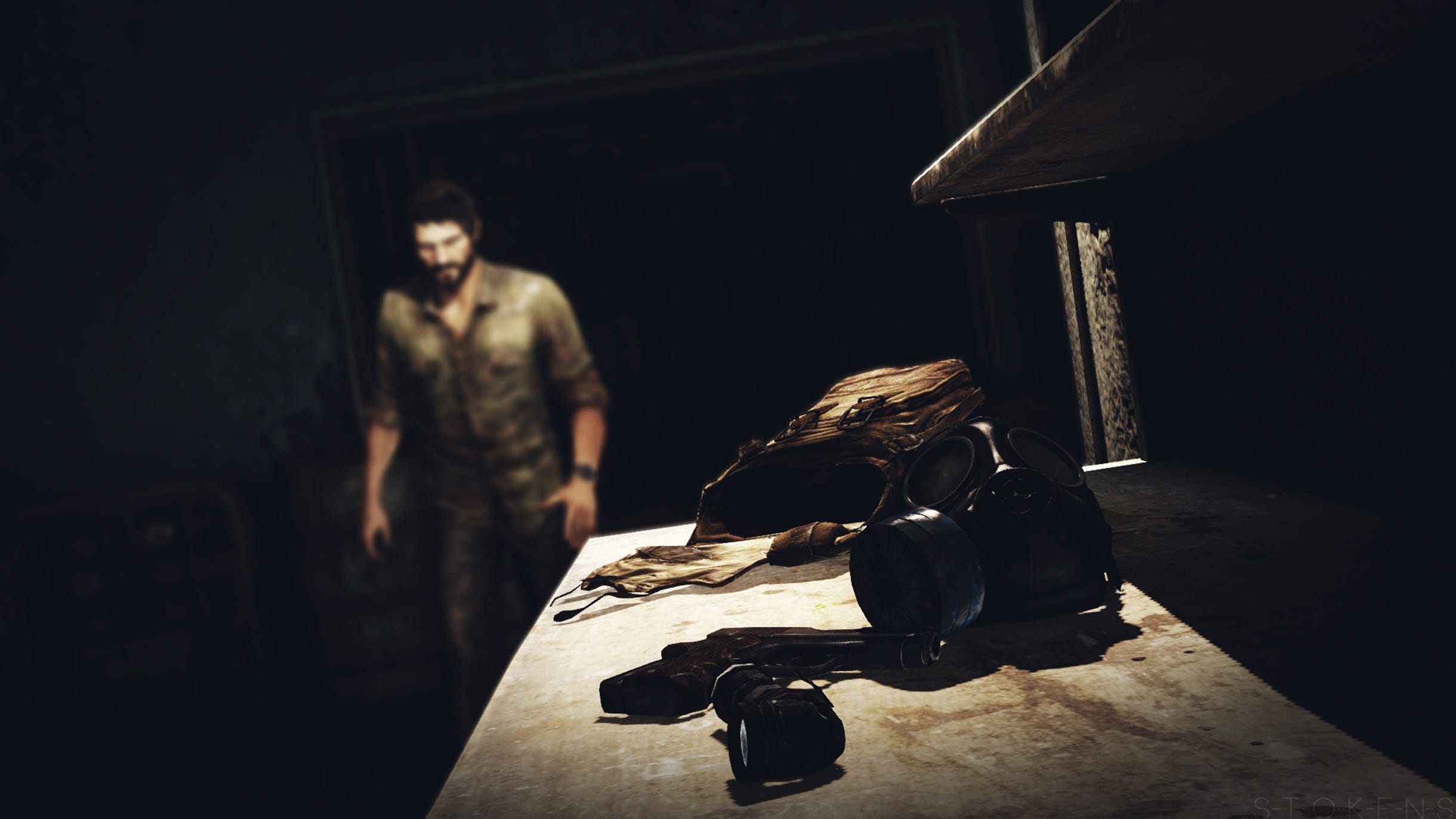
第1部分:收集手Craft.io品 (Part 1: Collecting crafting supplies)
清除策略 (Scavenging strategies)
The Last of Us is a linear game which features more open sections than previous Naughty Dog games. Gathering additional crafting supplies is the core motivation to explore all these extra spaces.
《最后的我们》是一款线性游戏,具有比以前的顽皮狗游戏更多的开放区域。 收集更多的手Craft.io品是探索所有这些额外空间的核心动机。
But they had a problem: with cluttered post-apocalyptic environments, making the player search crafting supplies by observation alone could have been akin to finding a needle in a haystack.
但是他们有一个问题:在世界末日混乱的环境中,让玩家仅靠观察就可以搜寻手Craft.io品,这可能类似于在大海捞针中找针。
Naughty Dog already puts a tremendous amount of effort into directing the player through its levels without relying on HUD. They would never add a radar or compass to point out interactive elements as most open games do. They opted instead to have a discreet icon appear when Joel is in the immediate proximity of an item.
顽皮狗已经在不依赖HUD的情况下付出了巨大的努力来引导玩家通过其关卡。 他们绝不会像大多数开放游戏一样添加雷达或指南针来指出交互元素。 他们选择在乔尔(Joel)紧邻某物品时显示谨慎的图标。
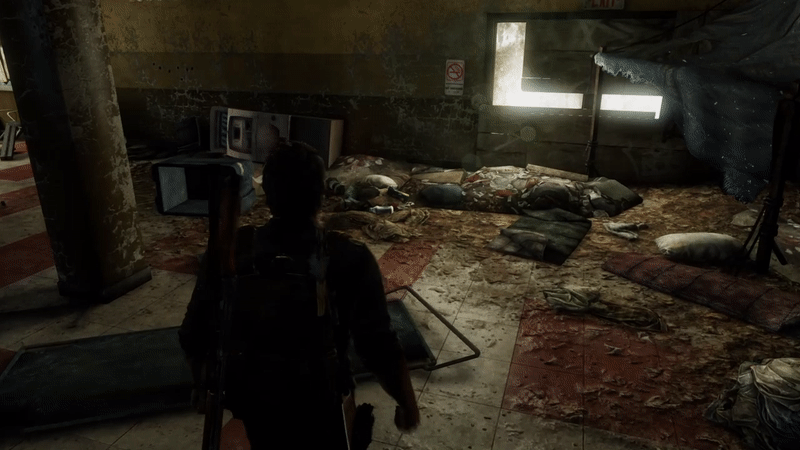
This mechanic eliminates almost entirely the observation challenge, which wouldn’t be fun even with the shiny shader, but it’s still entertaining. The player is now incited to approach exploration strategically: visit every room, check behind every cover and be on the lookout of the little icon that pops.
该机制几乎消除了观察方面的挑战,即使使用发亮的着色器也不会很有趣,但是仍然很有趣。 现在,该玩家被激发去战略性地进行探索:走访每个房间,检查每一个掩体的后面,并监视弹出的小图标。
Most pickups aren’t on the critical path of the level: if you rush, you only get a few, but if you conscientiously search through the entire play area, you gain several useful rewards. And more importantly, you get a real sense of discovery. The Last of Us is a linear game, yet ironically it makes you experience exploration better than open-world games in which you only go from an icon on a map to another.
大多数拾音器不在关卡的关键路径上:如果着急,您只会得到一些,但是如果您认真搜索整个游戏区域,则会获得一些有用的奖励。 更重要的是,您将获得真正的发现感。 《最后的我们》是一款线性游戏,但具有讽刺意味的是,它使您比仅在地图上的一个图标进入另一个图标的开放世界游戏更好地体验探索。
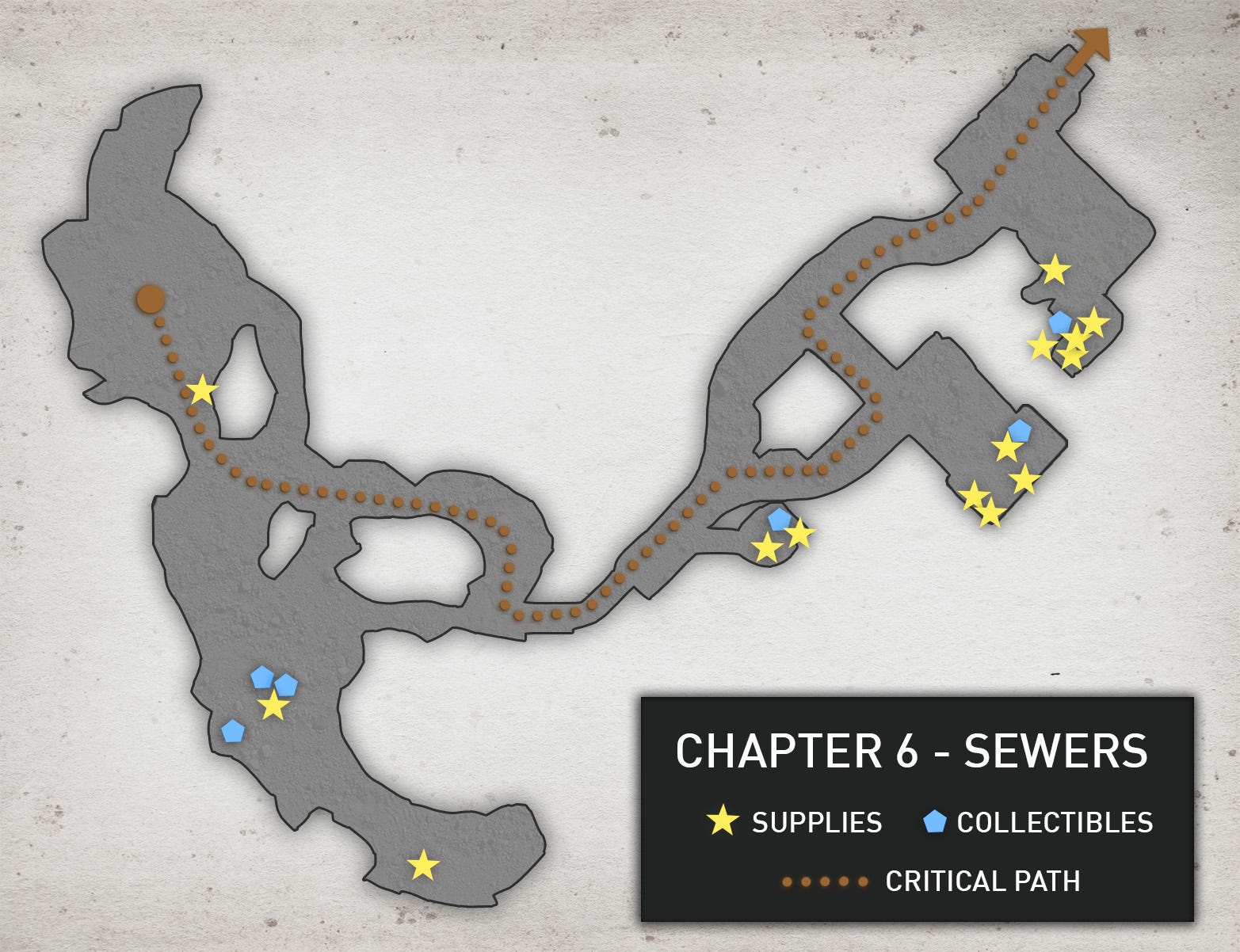
处理不同游戏风格的节奏 (Handling pacing for different playstyles)
Each section with enemies, whether human or infected, feels particularly tense in The Last of Us. Joel is capable of handling many threats, but not at once. Unlike in action games, you rarely feel comfortable doing so.
在《我们的最后》中,每个遇到敌人的部分,无论是人类还是被感染者,都感到特别紧张。 乔尔有能力应对许多威胁,但不能一次。 与动作游戏不同,您很少会感到自在。
Stealth is encouraged, you have limited ammo and often need to retreat to cover. The game also needs to balance the crafting supplies to maintain permanent pressure during those phases. If the player ever has too much, they won’t feel threatened and won’t approach situations as carefully as intended.
鼓励进行隐身,弹药有限,并且经常需要撤退才能掩护。 游戏还需要平衡手工用品,以在这些阶段中保持永久压力。 如果玩家拥有过多的东西,他们将不会感到受到威胁,也不会像预期的那样谨慎对待情况。
Achieving this in a linear experience might seem simple on paper but in any game where the player has freedom of approach, striking the appropriate balance is difficult. How did the player overcome previous situations? Did they waste all their stuff or manage to save a lot? How much do they explore? What is their experience with video games in general?
在线性体验中实现这一目标在纸上似乎很简单,但是在任何玩家具有进近自由度的游戏中,要达到适当的平衡都是困难的。 玩家如何克服以前的情况? 他们浪费了所有东西还是设法节省了很多钱? 他们探索了多少? 他们在视频游戏方面的总体经验如何?
To address this complex design problem, Naughty Dog likely implemented a smart system to adjust the spawning of crafting supplies and ammo based on the player current inventory and selected difficulty level. I suspect they sometimes even decide the contents of drawers and cabinets at the last moment, right before they are actually opened.
为了解决这个复杂的设计问题,顽皮狗可能实施了一个智能系统,根据玩家当前的存货和选定的难度级别来调整手Craft.io品和弹药的产生。 我怀疑他们有时甚至在最后一刻才决定抽屉和橱柜的内容,就在它们真正打开之前。

With this dynamic balancing, they ensure the player always has some supplies to craft items regularly, yet is never overpowered. Inventory limits (three of each item) also help to prevent hoarding.
通过这种动态平衡,它们可以确保玩家始终有一些补给品可以定期制作手Craft.io品,但绝不会过分用功。 库存限制(每个物品三个)也有助于防止ho积。
This design solution is clever because it brings back all types of players closer to the intended experience. As a designer, you can’t just plan for the ‘ideal average’. You need to account for the ‘extremes’ too.
这种设计解决方案很聪明,因为它可以使所有类型的玩家更加接近预期的体验。 作为设计师,您不能仅仅为“理想平均值”做计划。 您还需要考虑“极端”。
Even if your system encourages a particular playstyle (here: exploration and strategy), your duty as a designer is to entertain everyone, not just those who obediently follow the rules you wrote for them.
即使您的系统鼓励一种特定的游戏风格(在这里:探索和策略), 作为设计师的您的职责也是娱乐所有人,而不仅仅是顺从地遵循您为他们编写的规则的人。

An excellent illustration of this philosophy is the ‘gift’ mechanic: when you’re very low on health or ammo, allies occasionally drop you some.
这种“礼物”机制就是一个很好的例证:当您的健康或弹药水平很低时,盟友有时会丢给您一些东西。
Naughty Dog designers don’t fall in the ego trap of the creator: they don’t punish the player for failing at the game, they don’t turn it into a lecture either, they just subtly help players to get back on track.
顽皮狗的设计师不会陷入创造者的自我陷阱:他们不会惩罚因游戏失败而导致的玩家,也不会将其变成演讲,他们只是巧妙地帮助玩家重回正轨。

第2部分:使用项目 (Part 2: Using items)
The Last of Us has six items to craft. It’s relatively few compared to other crafting systems, but quality prevails over quantity: each brings a unique gameplay possibility and reinforces player autonomy.
我们中的最后一个有六个项目可以制作。 与其他制作系统相比,它相对较少,但质量胜于数量:每种系统都带来独特的游戏可能性,并增强了玩家的自主权。

健康包 (Health Kit)
Using the health kit grants you a large chunk of health points. Simple as that. You’re vulnerable during the long seconds of application, which creates tension when you have to heal during the battle and only found a precarious hidden spot to do so.
使用健康套件可以为您提供大量的健康点。 就那么简单。 在长时间的应用过程中,您很容易受到攻击,这在您必须在战斗中进行治疗时会产生紧张感,并且只能找到一个不稳定的隐患。
希夫 (Shiv)
The Shiv is a more profound item with several possible uses; the player must decide whether they want to spend them to:
Shiv是一个更深刻的项目,具有多种可能的用途。 玩家必须决定是否要花费他们:
- Execute ‘runners’ and human enemies twice as fast as the free strangulation, which can be decisive in stealth situations. 处决“流浪者”和人类敌人的速度是自由绞杀的两倍,这在隐身情况下可能起决定性作用。
- Kill the ‘clickers’, powerful infected which otherwise instantly murder you. 杀死被强大感染的“咔哒声”,否则立即将您杀死。
- Open ‘shiv doors’, caches filled with many supplies and items. 打开“储物柜门”,存放许多物资和物品的高速缓存。

Between the three, you quickly realise that faster stealth kills are the least interesting option to waste a shiv on. Which leaves us with this decision: should I spend my shivs to handle a clicker or to open the shiv door for additional rewards?
在这三个之间,您很快就会意识到,更快的隐形击杀是浪费时间的最不有趣的选择。 这让我们做出了这样的决定:我应该花我的湿屑来处理答题器还是打开湿屑门以获得更多奖励?
The Last of Us is a linear game: when you get in front of a door with no possible way to open it, you must move on knowing you’re missing whatever was behind. You want to anticipate and save shivs to prevent this. But conversely, whenever you get slaughtered by a clicker, you seriously reconsider if the last door you spent a shiv on was worthwhile.
《最后的我们》是一个线性游戏:当您进入一扇门前而无法打开门时,您必须继续前进,直到知道自己丢失了背后的东西。 您要预料并保存碎片以防止这种情况。 但是相反地,每当您被答题器宰杀时,您都会认真考虑是否花了最后一口钱才值得。
The dilemma is intense.
困境非常严重。

近战武器升级 (Upgraded melee weapon)
It takes several hits to take down an enemy with your fists, a few with a melee weapon and just one (and a thrilling animation) with the craftable upgraded melee. Time is precious in combat situations with multiple threats.
用拳头击落一个敌人需要几次击中,使用近战武器需要击中几下,而可以制作的升级近战武器只有一个(和令人振奋的动画)。 在有多重威胁的战斗情况下,时间是宝贵的。

莫洛托夫鸡尾酒,指甲炸弹和烟雾弹 (Molotov cocktail, nail bomb & smoke bomb)
The Last of Us has three throwable items, each with its own speciality.
我们最后的人有3个可掷物品,每个物品都有自己的特色。
Molotov Cocktail burns enemies in a radius, fire also propagates and can ignite more targets.
莫洛托夫鸡尾酒在半径范围内燃烧敌人,火势还会蔓延并点燃更多目标。
Nail bomb does a lot of damage and only explodes when enemies are nearby, so you can also use it preventively as a land mine.
指甲炸弹会造成很大的伤害,并且只会在附近有敌人时才会爆炸,因此您也可以预防性地将其用作地雷。
Smoke bomb stuns any enemy within its area of effect, giving you time to either hide or rush towards the opponent.
烟雾弹会击晕其作用范围内的所有敌人,让您有时间躲藏或冲向对手。

解锁节奏 (The pacing of unlocking)
Naughty Dog is particularly vigilant when it comes to maintaining a smooth tempo for their games. Items discovery is no exception.
顽皮狗在保持游戏节奏平稳时尤其要保持警惕。 物品发现也不例外。
All six are unlocked one after the other throughout the first third of the game, outside of combat most of the time, so Naughty Dog also ensures the player fully dedicates their attention to noticing the new gameplay tool. Once the item is discovered, its craft recipe is unlocked and appears in the menu (which is almost empty and therefore not overwhelming at the start).
在整个游戏的前三分之一中,大部分时间都是在战斗之外的所有六个时间里,一个接一个地解锁的,因此调皮的狗还确保玩家充分专注于注意新的玩法工具。 一旦发现该物品,其Craft.io配方将被解锁并显示在菜单中(该菜单几乎为空,因此一开始不会让人感到不知所措)。
The only exception is for the Health Kit, which teaches us another design lesson. You get to use the item first and later get the recipe to craft it yourself. Tess also gives you whatever supplies you’re missing to make one on the spot.
唯一的例外是健康工具包,该工具包教给我们另一堂设计课程。 您可以先使用该物品,然后再获得自己制作的食谱。 苔丝还为您提供了当场制作所需的任何耗材。
Spreading tutorials is always a good idea (lesson 1 ‘Use health kit to heal’, lesson 2 ‘Crafting them’), so is ensuring the player can practice the theory directly. This moment isn’t the first time crafting, but reminders are never too much for the fundamental mechanics of your game.
散布教程始终是一个好主意(第1课“ 使用保健工具包治愈” ,第2课“ 制作它们” ),因此确保玩家可以直接练习该理论。 这一刻不是第一次,但提醒对于您的游戏基本原理永远不会太多。

第3部分:制作物品 (Part 3: Crafting items)
寻找合适的UX (Finding the right UX)
The crafting menu is split into three areas:
制作菜单分为三个区域:
- The left side is Joel checking inside his backpack. The game isn’t on pause, crafting is risky, and you have reduced view of your surroundings. 左侧是乔尔(Joel)在他的背包内检查。 游戏不会暂停,制作风险很大,您对周围环境的视线也有所减少。
- You select items in the central column, the wrench icon to indicating in a glance if you have enough supplies. 您在中间一栏中选择项目,扳手图标一目了然,以指示您是否有足够的耗材。
- On the right is the informative section, with both an overview of your inventory and input reminders. 右侧是信息部分,其中包含库存概述和输入提醒。

Alexandria Neonakis, the UI designer on the project, explained in this article how she designed the whole crafting flow so you’d need to spend a minimal amount of time in menus. She details the iterative process for the weapon interface, and we can assume the same for the crafting system.
该项目的UI设计师Alexandria Neonakis在本文中解释了她如何设计整个制作流程,因此您需要在菜单上花费最少的时间。 她详细介绍了武器界面的迭代过程,我们可以为制作系统假设相同的过程。
In the first gameplay demo showcased at E3 2012, the structure and visual look of menus were entirely placeholders for what looks like the same final system.
在E3 2012上展示的第一个游戏演示中,菜单的结构和视觉外观完全是占最终系统外观的占位符。
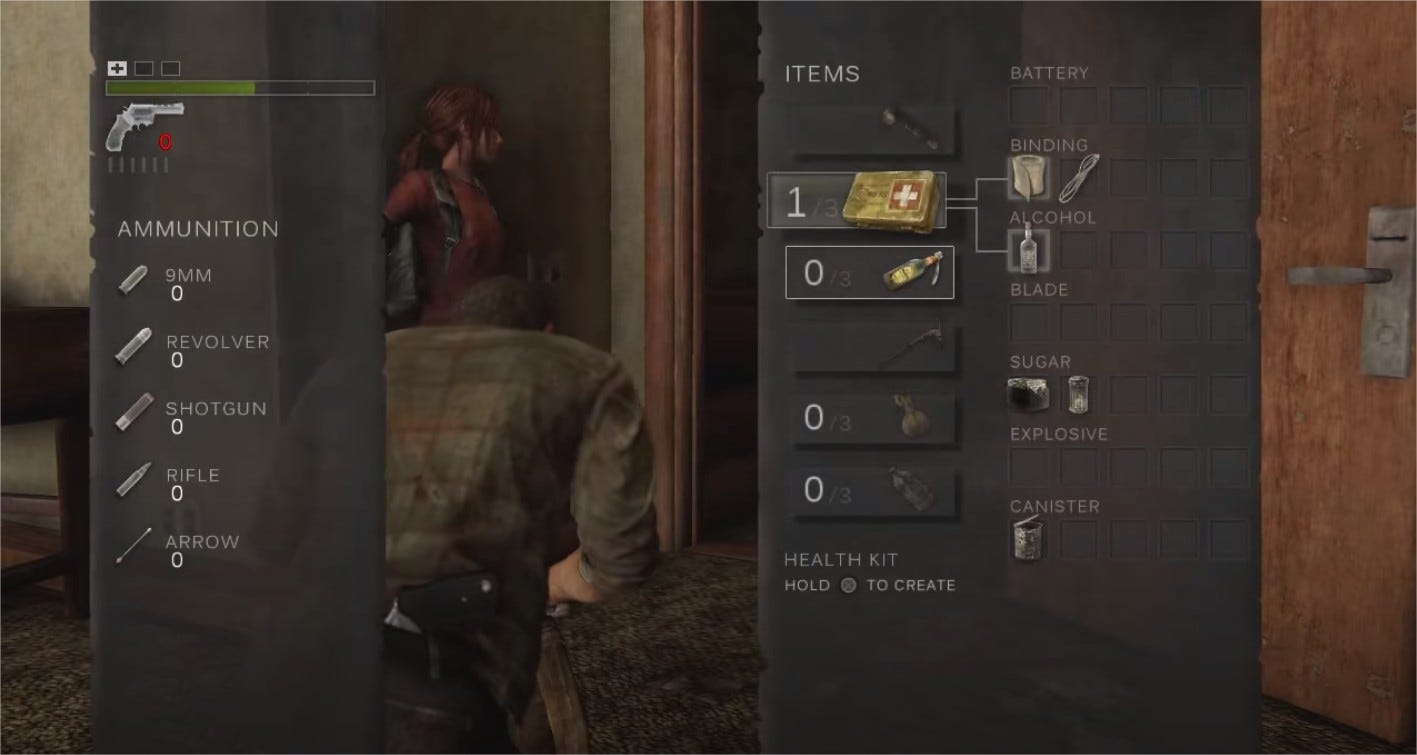
Alexandria was brought into the team in November 2012, only eight months before the game released. By early 2013, the menu wireframe was already there, although the art differs from the final result.
2012年11月,亚历山大(Alexandria)被带入车队,距离比赛发布只有八个月。 到2013年初 ,菜单线框已经存在,尽管其艺术与最终结果有所不同。

This version looks encumbered, especially the wall of icons: did they decide to switch to a max capacity of three because of it or was it purely based on the balancing efforts on gathering?
这个版本看起来很麻烦,尤其是图标墙:他们是因为这个决定决定切换到最大容量三,还是纯粹基于收集方面的平衡工作?
Although this version of the interface is lighter, it still has intense colours which stand out. It changed in the following months for silhouette icons, and the use of colour was kept minimal. The information is still clearly communicated to the player but subtly preserves the immersion.
尽管此版本的界面较轻,但它仍具有强烈的色彩,脱颖而出。 在接下来的几个月中,剪影图标发生了变化,并且对颜色的使用保持最少。 信息仍然清晰地传达给玩家,但巧妙地保留了沉浸感。
Even late in the production, Alexandria and the team never stopped making adjustments to increase clarity and usability. If you pay attention to menus in the making-of, you can spot numerous iterations. The examples below come from a single video; I count at least five differences with the final version.
甚至在生产后期,Alexandria和团队也从未停止过进行调整以提高清晰度和可用性。 如果您关注菜单中的菜单,则可以发现许多迭代。 下面的例子来自单个视频 ; 我认为最终版本至少有五个差异。

Hard work pays off. The result is honestly outstanding. Look at the gif below how effortlessly you can start from the item cross, hold the button to craft, then close the menu and use the health kit in a continuous motion.
付出就有收获。 结果是非常出色的。 查看下面的gif,您可以轻松地从商品交叉处开始,按住按钮进行制作,然后关闭菜单并连续使用健康套件。
All the info come in a glance, all the actions take a snap of fingers.
所有信息一目了然,所有动作都只需动一下手指即可。
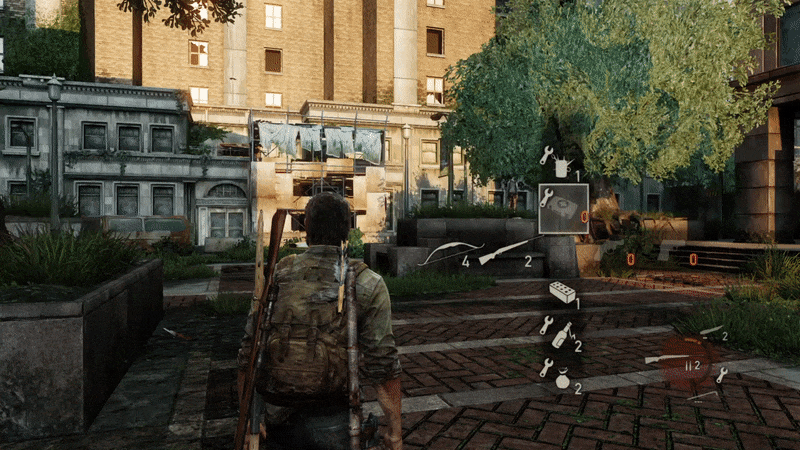
极简主义和沉浸感 (Minimalism and maintaining immersion)
Human brains have a hard time perceiving what’s missing; this is sometimes referred to as “absence blindness”.
人类的大脑很难感知缺失的事物。 这有时被称为“ 失明失明 ”。
At Naughty Dog, they know they can leverage this cognitive phenomenon to keep the player’s focus on the right elements. As I explained in a previous piece, they expertly, maybe unconsciously, avoid drawing attention to the latent weirdness of some game mechanics.
在Naughty Dog,他们知道他们可以利用这种认知现象来保持玩家对正确元素的关注。 正如我在上一篇文章中所解释的那样 ,他们会专业地(也许是在不知不觉中)避免引起人们对某些游戏机制潜在怪异的注意。

See what’s missing here from this crafting menu? Numbers.
看看这里的菜单缺少什么? 数字。
Here is the design problem: each recipe requires a combination of two components. You want to encourage the player to scavenge, which means giving supplies often enough, or they’ll be discouraged. But you also want to retain the tension and not have the player carry a whole arsenal. What’s the solution here?
这是设计问题:每个配方都需要两个组件的组合。 您想鼓励玩家进行清理,这意味着要经常提供足够的补给,否则就会灰心。 但是,您也想保持紧张局势,不要让球员携带整个武器库。 这里有什么解决方案?
Most games handle this by throwing in numbers and then figure out balancing: three of this and five of that turns into one item. This approach technically works, but it has the negative side effect of highlighting the rigidity of the crafting mechanic.
大多数游戏通过输入数字然后找出平衡来解决这一问题:其中三个和五个变成一项。 这种方法在技术上是可行的,但具有负面影响,即突出了手工技艺的刚性。
I had a go at applying this to The Last of Us and produced a mock-up of what it could have looked like to present supplies with numbers, with the exact same rules for the mechanic. Suddenly, you want to question why twelve is the limit for inventory. Immersion ruined.
我尝试将其应用到《最后的我们》中,并制作了一个模型,模拟了如何用数字为补给品提供物品,并具有与修理工完全相同的规则。 突然,您想质疑为什么库存限制为十二。 沉浸毁了。

Instead of numbers, The Last of Us present supplies in icon quarters which makes both for a cleaner design and give them the flexibility to scatter supplies. The vocabulary and the quantities are also kept intentionally vague (no ‘this pair of scissors you picked-up is worth 3 blades’).
《最后的我们》以数字形式展示了耗材,而不是数字, 这既使设计更整洁,又使它们可以灵活地分散耗材。 词汇和数量也故意保持模糊(没有“您拿起的这把剪刀不值3把刀片”)。
The more you try to justify it, the weirder it feels, so don’t.
您尝试证明其合理性的方法越多,感觉就越怪异,所以请不要。
Craft.io食谱的困境 (Dilemmas in craft recipes)
To create each item, you need to assemble two components (except the upgraded melee weapon). Designers iterated on the recipes throughout the project, as you might have seen from the early screenshots above, they cut batteries for flashlamps (probably too annoying in dark areas). Here is a diagram of the craft recipes in the final game.
要创建每个项目,您需要组装两个组件(升级后的近战武器除外)。 正如您从上面的早期屏幕截图中可能已经看到的那样,设计人员遍历整个项目的配方,他们削减了闪光灯的电池(在黑暗区域可能太烦人了)。 这是最终游戏中的Craft.io配方图。
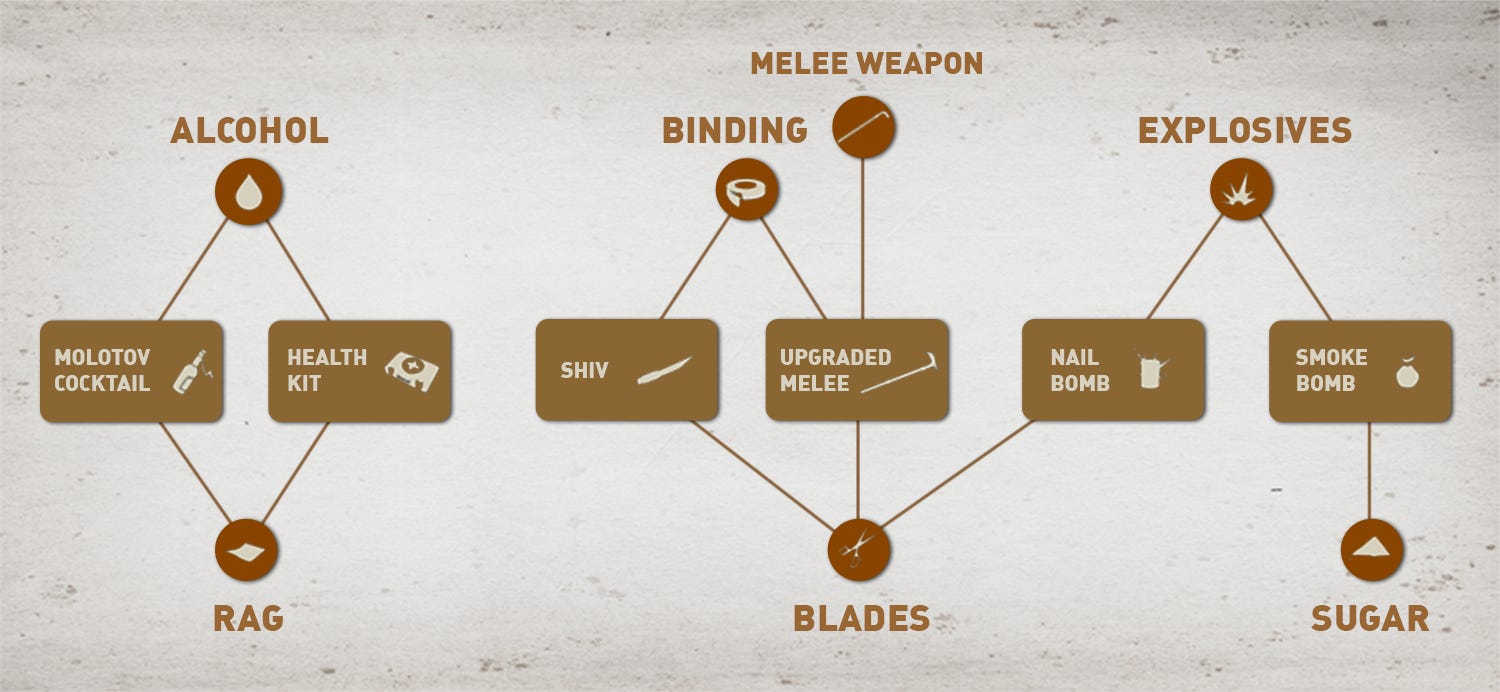
Presented this way, you can immediately spot the decisions on how to use your supplies. The pair alcohol/rag combination is the most obvious; the rest doesn’t have as discernable of a pattern (to break the monotony) but still clearly show designers made recipes to reinforce player choices.
通过这种方式呈现,您可以立即发现有关如何使用耗材的决定。 酒精/抹布对最为明显。 其余的没有一种可识别的模式(打破单调),但仍然清楚地表明设计师制定了配方来加强玩家的选择。
When you come across supplies, you always pick them. Designers could have made scavenging a choice with a rule such as “you’re faster when your backpack is empty”, which is coherent within the narration, but they didn’t. They want the player to fill their inventory to have choices on how to spend it.
当您遇到耗材时,您总是会选择它们。 设计师本可以通过诸如“背包空着时会更快”之类的规则来做出选择,但这在叙述中是连贯的,但事实并非如此。 他们希望玩家填充他们的库存,以选择如何使用它。
Most of the time, the player faces some dilemmas in the crafting menu. Even if you carry very few supplies, the recipe design has a high probability of having more than one craftable item. This design decision has two benefits for the experience.
大多数时候,玩家在制作菜单中面临一些难题。 即使您只携带很少的补给品,配方设计也很可能拥有多个可加工的物品。 该设计决策对于体验有两个好处。
Firstly, being forced to make a choice emphasises how important it is to scavenge. You hate to have such limited supplies, only to be forced to choose between nail bomb and upgraded melee — you really want them both.
首先,被迫做出选择强调了清除的重要性。 您不愿拥有如此有限的补给品,而只能被迫在钉子炸弹和升级的近战中进行选择-您真的希望两者兼具。
Secondly, you can directly correlate your past decisions with your current situation; sometimes they will be reinforced, other times they will be a source of regret. Items fit into different strategies, and you don’t know in advance what you’ll encounter. You decide based on incomplete information and hope for the best.
其次,您可以将过去的决策与当前的状况直接关联起来; 有时他们会得到加强,其他时候他们会成为遗憾的源头。 项目适合不同的策略,并且您事先不知道会遇到什么。 您根据不完整的信息做出决定,并希望获得最好的结果。
These are the great choices in games, the ones you remember and reflect on later.
这些是游戏中的绝佳选择,您会记得并在以后进行反思。

结论 (Conclusion)
The Last of Us doesn’t have the deepest crafting system ever seen in gaming; it doesn’t have hundreds of recipes; it doesn’t allow any creativity. But it’s still one of the greatest I’ve played with because it expertly conveys the narrative intentions of the experience.
《最后的我们 》没有游戏中最深的制作系统; 它没有数百种食谱; 它不允许任何创造力。 但这仍然是我玩过的最棒的游戏之一,因为它可以熟练地传达体验的叙事意图。
The permanent tension, the never-wracking dilemmas. A feeling of scarcity balanced by the joys of surprising exploration. A rewarding need to have a careful, methodic approach to each encounter.
永久的紧张局势,永无止境的困境。 一种稀缺的感觉与令人惊奇的探索乐趣相平衡。 对于每次遇到的问题,都需要采取认真,系统的方法来解决。

It’s what good entertainment is all about: to take you on a journey and make you experience powerful emotions. The Last of Us is unique because it accomplishes this thanks to a well-crafted story, characters, and art design. Equally compelling are the clever gameplay and system design that work so effectively that you don’t even notice.
这就是好的娱乐的全部内容:带您踏上旅途,让您体验强烈的情感。 《最后的我们》之所以与众不同,是因为它通过精心制作的故事,人物和艺术设计来实现这一目标。 同样引人注目的是聪明的游戏玩法和系统设计,它们如此有效地工作,以至于您甚至都没有注意到。
翻译自: https://medium.com/super-jump/the-brilliant-crafting-system-in-the-last-of-us-bb33f221f2c1
出色的社区网站
本文来自互联网用户投稿,该文观点仅代表作者本人,不代表本站立场。本站仅提供信息存储空间服务,不拥有所有权,不承担相关法律责任。如若转载,请注明出处:http://www.mzph.cn/news/275785.shtml
如若内容造成侵权/违法违规/事实不符,请联系多彩编程网进行投诉反馈email:809451989@qq.com,一经查实,立即删除!






》...)








)


